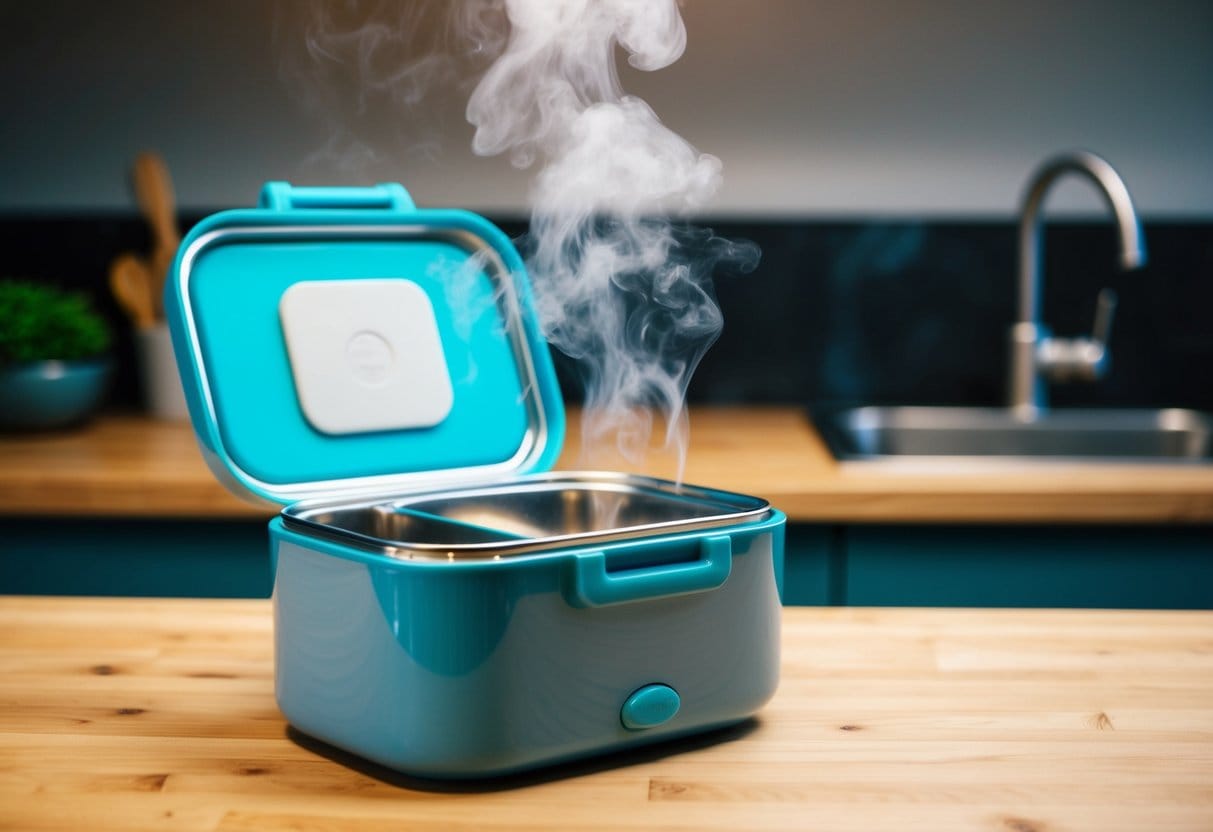Are you worried about hidden pesticides and bacteria on your fresh produce?
A vegetable washing machine provides a hassle-free way to thoroughly clean fruits and vegetables before consumption. Simply rinsing with water is often not enough to remove dirt, chemicals, and harmful contaminants, risking your health.
With a vegetable washing machine, you can effortlessly eliminate pesticides and bacteria using advanced cleaning technology, giving you peace of mind and a healthier diet for you and your family.
We earn a commission if you purchase at no additional cost to you.
Vegetable washing machines employ advanced methods like ozone or electrolysis to clean produce more effectively than hand washing alone. Some models create OH-ions to purify fruits and vegetables, while others use electrolyzed water to remove contaminants. These machines are designed to be easy to use, often requiring just water and the press of a button to start the cleaning process.
Various options are available, from portable devices to larger countertop models. Many are designed to clean multiple types of produce, including fruits, vegetables, and even rice. When choosing a vegetable washing machine, consider size, cleaning technology, and ease of use to find the best fit for your kitchen.
Key Takeaways
- Vegetable washing machines use advanced technologies to remove pesticides and bacteria from produce.
- You can choose from portable or countertop models to suit your kitchen space and cleaning needs.
- These devices offer a quick and efficient way to clean your fruits and vegetables before consumption thoroughly.
Overview of Vegetable Washing Machines
Vegetable washing machines offer an efficient solution for cleaning produce. These devices use water and air bubbles to remove dirt, pesticides, and other contaminants from fruits and vegetables.
Essential Functions
Vegetable washing machines thoroughly clean produce. They use a combination of water jets and air bubbles to dislodge dirt and residues. Many models offer multiple cleaning cycles for different types of produce. Some machines can remove up to 99% of pesticides and other surface contaminants.
You’ll find options with additional features like UV sterilization or ozone treatment for extra sanitation. Most units are designed to be gentle on delicate produce while providing effective cleaning. Some models also offer drying functions to remove excess water after washing.
Types of Machines
You can choose from several types of vegetable washing machines. Countertop models are compact and suitable for home use. These typically handle smaller quantities of produce at a time.
Larger, freestanding units are ideal for commercial kitchens or households that process large amounts of fruits and vegetables. Some machines use ultrasonic technology for deep cleaning. Others rely on bubble generation systems.
Portable, battery-operated washers are available for camping or travel. Industrial-scale machines for food processing facilities can clean large volumes of produce quickly and efficiently.
Benefits of Using Vegetable Washing Machines
Vegetable washing machines offer significant advantages for home and commercial kitchens. These appliances provide thorough cleaning while saving time and resources.
Hygiene and Safety
Vegetable washing machines ensure superior hygiene compared to manual washing. You can remove pesticides, dirt, and harmful bacteria more effectively. The machines use gentle agitation and rotation to dislodge contaminants without damaging produce.
Many models incorporate multi-stage cleaning processes. These may include rinsing, ozone treatment, and drying cycles. Such comprehensive cleaning reduces the risk of foodborne illnesses.
Washing machines are handy for cleaning leafy greens and other hard-to-wash items. You can clean large quantities of produce quickly and consistently.
Efficiency and Water Conservation
Using a vegetable washing machine saves you time and effort in the kitchen. You can clean multiple items simultaneously, streamlining your food preparation process.
These appliances are designed for water efficiency. They use less water than traditional sink-washing methods. Some models even recycle water during the cleaning cycle.
The machines are easy to operate, often featuring simple controls and preset programs. You can achieve professional-level cleaning results without specialized skills.
Many units are compact and fit easily on countertops. This makes them suitable for both home and commercial kitchens with limited space.
Key Features to Consider
When selecting a vegetable washing machine, focus on features that enhance cleaning efficiency and user convenience. Pay attention to the device’s capacity, technological capabilities, and ease of use to find the best fit for your needs.
Capacity and Size
Choose a vegetable washer that matches your typical produce volume. Compact models suit individuals or small families, while larger units cater to bigger households or frequent entertainers. Consider available counter space and storage options.
Most machines hold 3-5 liters of water. This capacity adequately cleans a standard grocery haul. Some units feature adjustable water levels for flexibility.
Check the device’s weight if you plan to move it often. Lighter models (1-2 kg) offer portability, while heavier ones (3-4 kg) may provide more stability during operation.
Technology Employed
Look for washers with innovative cleaning methods. Dual-core technology can cut cleaning time in half compared to single-core models. This feature is handy for busy households.
Bubble washing technology creates micro-bubbles that penetrate produce surfaces, removing dirt and pesticides more effectively. It’s gentler on delicate fruits and vegetables.
Consider machines with rechargeable batteries for cordless operation. A 3000mAh battery typically provides enough power for multiple cleaning cycles. Some models offer wireless charging for added convenience.
Opt for easy-to-operate designs with simple controls. One-button operation streamlines the cleaning process, making it accessible for all family members.
Popular Models and Brands
Vegetable washing machines come in various sizes and types to suit different needs. Several brands offer reliable options for both commercial and home use, with features like ozone generation for enhanced cleaning.
Commercial-Grade Machines
Nilma stands out as a leading brand for commercial vegetable washers. Their models often feature high-capacity drums and robust spray systems for efficiently cleaning large produce quantities. These machines typically have stainless steel construction for durability and easy maintenance.
Some commercial models offer conveyor belt systems, allowing continuous operation in busy restaurant kitchens or food processing facilities. They may include adjustable wash cycles and water pressure settings to accommodate different types of produce.
Commercial-grade vegetable washers often incorporate advanced filtration systems to remove contaminants and recirculate water, promoting sustainability in professional kitchens.
Home Kitchen Models
For home use, compact countertop vegetable washers are gaining popularity. These units are designed to fit easily in your kitchen and efficiently clean smaller batches of produce.
Many home models feature ultrasonic cleaning technology, using high-frequency sound waves to remove dirt and pesticides from fruits and vegetables. Some popular brands offer USB-rechargeable portable washers, providing convenience for small households or travel.
Look for home vegetable washing machines with multiple cleaning modes and timer settings. These features allow you to customize the cleaning process based on the type and quantity of produce you’re washing.
Ozone Generator Fruit and Vegetable Washing Machine
Ozone generator vegetable washers are becoming increasingly sought-after for effectively eliminating bacteria and pesticides without chemicals. These machines produce ozone, a powerful oxidizing agent, to sanitize your produce.
Some models combine ozone generation with water circulation for thorough cleaning. They often feature transparent containers, allowing you to monitor the cleaning process.
Ozone generator washers are available in both commercial and home-use sizes. When choosing an ozone model, consider factors like ozone concentration levels and safety features to ensure effective and safe operation in your kitchen.
This device is certainly worth a look for those who prioritize food safety and are willing to invest more time in meal preparation. The added reassurance it brings to your kitchen routine more than compensates for the extra steps involved. While it does require a slight adjustment to your food prep habits, many users find that the confidence in knowing their produce is thoroughly cleaned outweighs the minor inconvenience. If you value peace of mind regarding what you’re putting on your plate, this tool could be a game-changer in your daily cooking routine.
Operational Considerations
Proper operation of a vegetable washing machine ensures optimal cleaning and longevity of the equipment. Key factors include regular maintenance and following correct usage instructions.
Maintenance Requirements
Clean the machine after each use to prevent residue buildup. Remove any debris from filters and brushes. Inspect seals and gaskets monthly, replacing worn parts promptly. Lubricate moving components as recommended by the manufacturer.
Check the water pressure and flow regularly. Descale the system every 3-6 months, depending on water hardness. Replace brushes when bristles show wear.
For battery-operated models, charge fully before use. Store in a cool, dry place when not in use. Have a professional service the machine annually for optimal performance.
Usage Instructions
Load vegetables into the washer, avoiding overfilling. Select the appropriate wash cycle based on produce type and soil level. Use cold water for leafy greens and delicate items.
Add a food-safe cleaning solution if desired. Start the machine and monitor the process. For root vegetables, longer cycles may be necessary.
After washing, drain the machine completely. Remove clean produce promptly to prevent recontamination. Rinse the interior thoroughly between batches.
For portable units, ensure a stable surface before operation. Follow manufacturer guidelines for water usage to conserve resources while maintaining cleaning efficacy.
Installation and Maintenance
Proper setup and regular upkeep are crucial for the optimal performance of your vegetable washing machine. Following the manufacturer’s guidelines ensures efficient operation and longevity of the equipment.
Setting Up Your Machine
Position your vegetable washing machine on a level surface with adequate drainage. Connect it to a reliable water source and power supply. Ensure proper ventilation around the unit to prevent overheating.
Check that all components are securely fastened and aligned. Install any removable parts like brushes or screens according to the manual. Adjust the water pressure and flow rate to suit your specific needs.
Test the machine with a small batch of vegetables before full-scale operation. Verify that the washing cycle works correctly and produces clean results. Make any necessary adjustments to settings or attachments.
Routine Maintenance Tasks
Clean your vegetable washing machine thoroughly after each use. Remove any debris from screens, filters, and brushes. Wipe down surfaces with a mild detergent solution.
Inspect belts, chains, and sprockets regularly for signs of wear or damage. Lubricate moving parts as recommended by the manufacturer. Replace worn components promptly to prevent breakdowns.
Check and clean water nozzles to ensure even spray distribution. Descale the machine periodically if you have hard water. Sanitize the entire unit weekly using a food-safe disinfectant.
Monitor the machine’s performance and address any unusual noises or vibrations immediately. Keep a maintenance log to track cleaning, repairs, and part replacements.
Industry and Market Trends
The vegetable washing machine industry is experiencing rapid growth and innovation. Technological advances and increased consumer demand drive market expansion and new product development.
Innovation and Advancements
Manufacturers are incorporating innovative features into vegetable washing machines. You’ll find models with multiple washing modes, adjustable water pressure, and automatic detergent dispensing. Some machines now use ultrasonic cleaning technology to remove pesticides and bacteria effectively.
Energy efficiency is a key focus. New designs consume less water and electricity while maintaining cleaning performance. Compact countertop models are gaining popularity for smaller households and kitchens with limited space.
Eco-friendly materials are being used in construction. You’ll see machines made with recyclable plastics and biodegradable components. This appeals to environmentally conscious consumers.
Market Growth and Demand
The global fruit and vegetable washing machine market is projected to reach $1.2 billion by 2028, growing at a 6.5% CAGR. Increased awareness of food safety and hygiene drives adoption in homes and businesses.
Asia-Pacific is the fastest-growing region due to rising disposable incomes and changing lifestyles. North America and Europe remain strong markets, with consumers seeking convenient cleaning solutions.
Vegetable processing companies are major buyers of industrial washing machines. These larger units are found in food production facilities, restaurants, and supermarkets. The industrial segment is expected to grow 6.7% CAGR through 2029.
Environmental Impact and Sustainability
Vegetable washing machines offer eco-friendly solutions to reduce water usage and energy consumption. These innovative appliances incorporate features and practices that minimize environmental impact while effectively cleaning produce.
Eco-Friendly Features
Modern vegetable washing machines utilize advanced technologies to conserve resources. Many models feature water recycling systems that filter and reuse water, significantly reducing overall consumption. You’ll find machines with adjustable water levels, allowing you to use only what’s necessary for your produce load.
Energy-efficient motors and pumps help lower electricity usage. Some washers incorporate solar panels or can be connected to renewable energy sources. LED lighting replaces traditional bulbs, further decreasing energy demands.
Intelligent sensors detect soil levels and adjust cleaning cycles accordingly, preventing unnecessary water and energy use. Biodegradable cleaning agents are often recommended, minimizing chemical runoff.
Sustainable Practices in Vegetable Washing
You can adopt several sustainable practices when using your vegetable washing machine. Opt for full loads to maximize efficiency and reduce the number of wash cycles. Choose the shortest appropriate cycle for lightly soiled produce.
Consider collecting and repurposing rinse water for gardening or other non-potable uses. Regularly maintain your machine to ensure optimal performance and longevity, reducing the need for premature replacement.
When shopping, look for machines with eco-certifications or Energy Star ratings. These indicate adherence to strict environmental standards. Selecting a durable, high-quality washer’ll minimize the frequency of replacements and associated manufacturing impacts.
Frequently Asked Questions
Vegetable washing machines offer various benefits and features for home and commercial use. Understanding key aspects like advantages, selection criteria, and different technologies can help users make informed decisions.
How do vegetable washing machines benefit home users?
Vegetable washing machines save time and effort for home users. They efficiently clean multiple fruits and vegetables simultaneously, removing dirt, pesticides, and bacteria more thoroughly than manual washing. These devices also help preserve produce freshness and extend shelf life.
What are the advantages of electric vegetable washing machines over manual washing?
Electric vegetable washers provide consistent and thorough cleaning. They use gentle agitation to remove contaminants without damaging delicate produce. These machines are more water-efficient than manual washing and can quickly clean larger quantities of fruits and vegetables.
What features should be considered when selecting a commercial vegetable washing machine?
Capacity is crucial for commercial machines. Look for adjustable wash cycles and water pressure settings to accommodate different produce types. Durable construction, energy efficiency, and ease of cleaning are important factors. Consider machines with sorting and grading capabilities for increased productivity.
Are there any small-scale vegetable washing machines suitable for startups?
Yes, compact vegetable washers are available for small businesses. These machines offer features like multiple wash cycles and adjustable timers. Some models are portable and ideal for farmers’ markets or small-scale operations with limited space.
How do ozone vegetable washing machines differ from traditional washers?
Ozone vegetable washers use ozone-infused water to clean produce. This technology provides enhanced disinfection, effectively eliminating bacteria and pesticides. Ozone washers often require less water and cleaning agents than traditional methods, making them more environmentally friendly.





